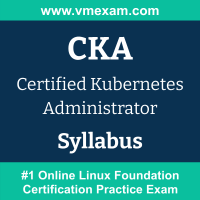 The Linux Foundation CKA exam preparation guide is designed to provide candidates with necessary information about the Kubernetes Administrator exam. It includes exam summary, sample questions, practice test, objectives and ways to interpret the exam objectives to enable candidates to assess the types of questions-answers that may be asked during the Certified Kubernetes Administrator (CKA) exam.
The Linux Foundation CKA exam preparation guide is designed to provide candidates with necessary information about the Kubernetes Administrator exam. It includes exam summary, sample questions, practice test, objectives and ways to interpret the exam objectives to enable candidates to assess the types of questions-answers that may be asked during the Certified Kubernetes Administrator (CKA) exam.
It is recommended for all the candidates to refer the CKA objectives and sample questions provided in this preparation guide. The Linux Foundation CNCF Kubernetes Administrator certification is mainly targeted to the candidates who want to build their career in Cloud & Containers domain and demonstrate their expertise. We suggest you to use practice exam listed in this cert guide to get used to with exam environment and identify the knowledge areas where you need more work prior to taking the actual Certified Kubernetes Administrator exam.
Linux Foundation CKA Exam Summary:
|
Exam Name
|
Certified Kubernetes Administrator |
| Exam Code | CKA |
| Exam Price | $445 USD |
| Duration | 120 minutes |
| Number of Questions | 15-20 |
| Passing Score | 66% |
| Recommended Training / Books | Kubernetes Fundamentals (LFS258) |
| Schedule Exam | Linux Foundation |
| Sample Questions | Linux Foundation CKA Sample Questions |
| Recommended Practice | Certified Kubernetes Administrator (CKA) Practice Test |
Linux Foundation Kubernetes Administrator Syllabus:
| Section | Objectives | Weight |
|---|---|---|
| Storage |
- Implement storage classes and dynamic volume provisioning - Configure volume types, access modes and reclaim policies - Manage persistent volumes and persistent volume claims |
10% |
| Troubleshooting |
- Troubleshoot clusters and nodes - Troubleshoot cluster components - Monitor cluster and application resource usage - Manage and evaluate container output streams - Troubleshoot services and networking |
30% |
| Workloads & Scheduling |
- Understand application deployments and how to perform rolling update and rollbacks - Use ConfigMaps and Secrets to configure applications - Configure workload autoscaling - Understand the primitives used to create robust, self-healing, application deployments - Configure Pod admission and scheduling (limits, node affinity, etc.) |
15% |
| Cluster Architecture, Installation & Configuration |
- Manage role based access control (RBAC) - Prepare underlying infrastructure for installing a Kubernetes cluster - Create and manage Kubernetes clusters using kubeadm - Manage the lifecycle of Kubernetes clusters - Implement and configure a highly-available control plane - Use Helm and Kustomize to install cluster components - Understand extension interfaces (CNI, CSI, CRI, etc.) - Understand CRDs, install and configure operators |
25% |
| Services & Networking |
- Understand connectivity between Pods - Define and enforce Network Policies - Use ClusterIP, NodePort, LoadBalancer service types and endpoints - Use the Gateway API to manage Ingress traffic - Know how to use Ingress controllers and Ingress resources - Understand and use CoreDNS |
20% |
